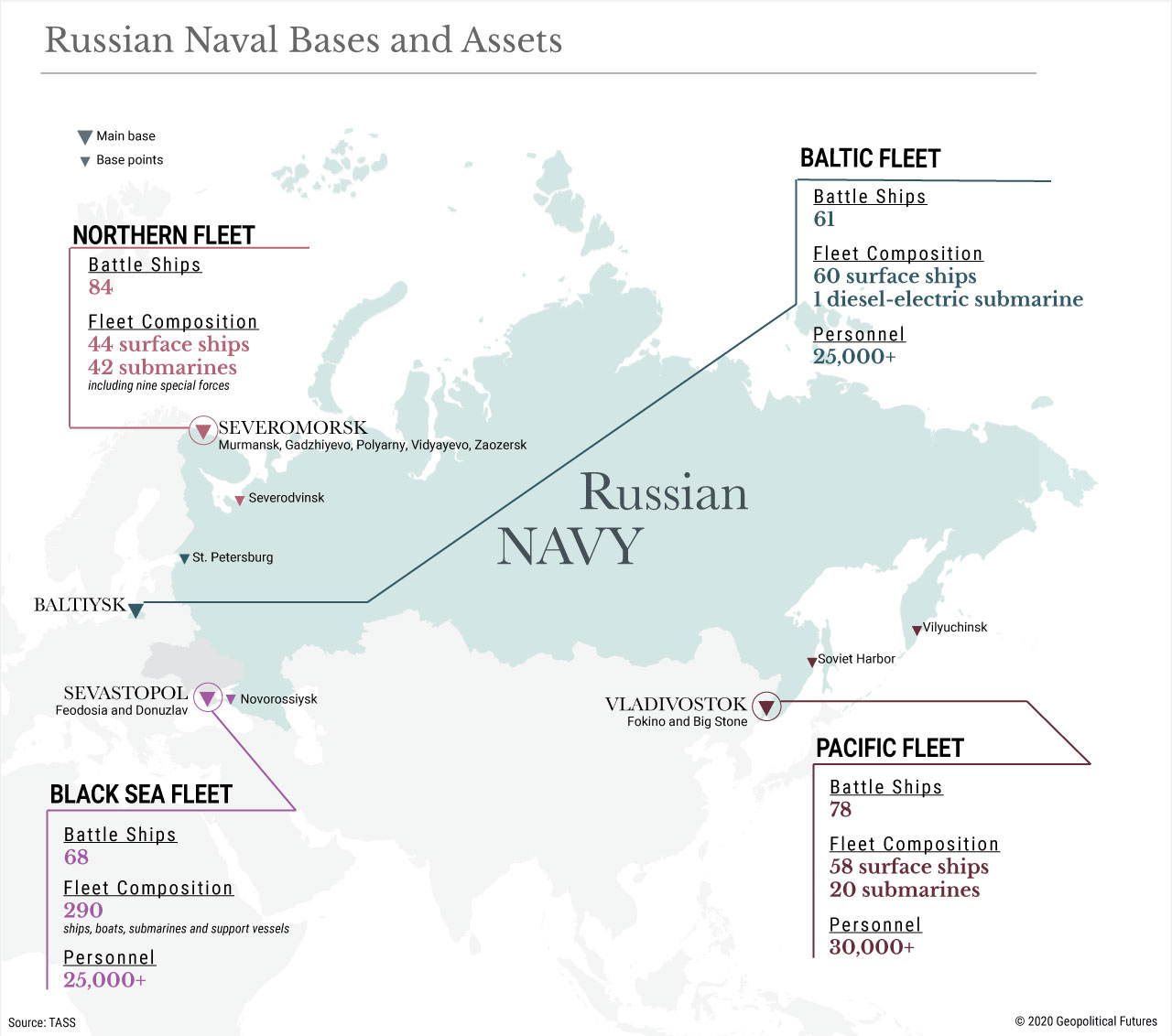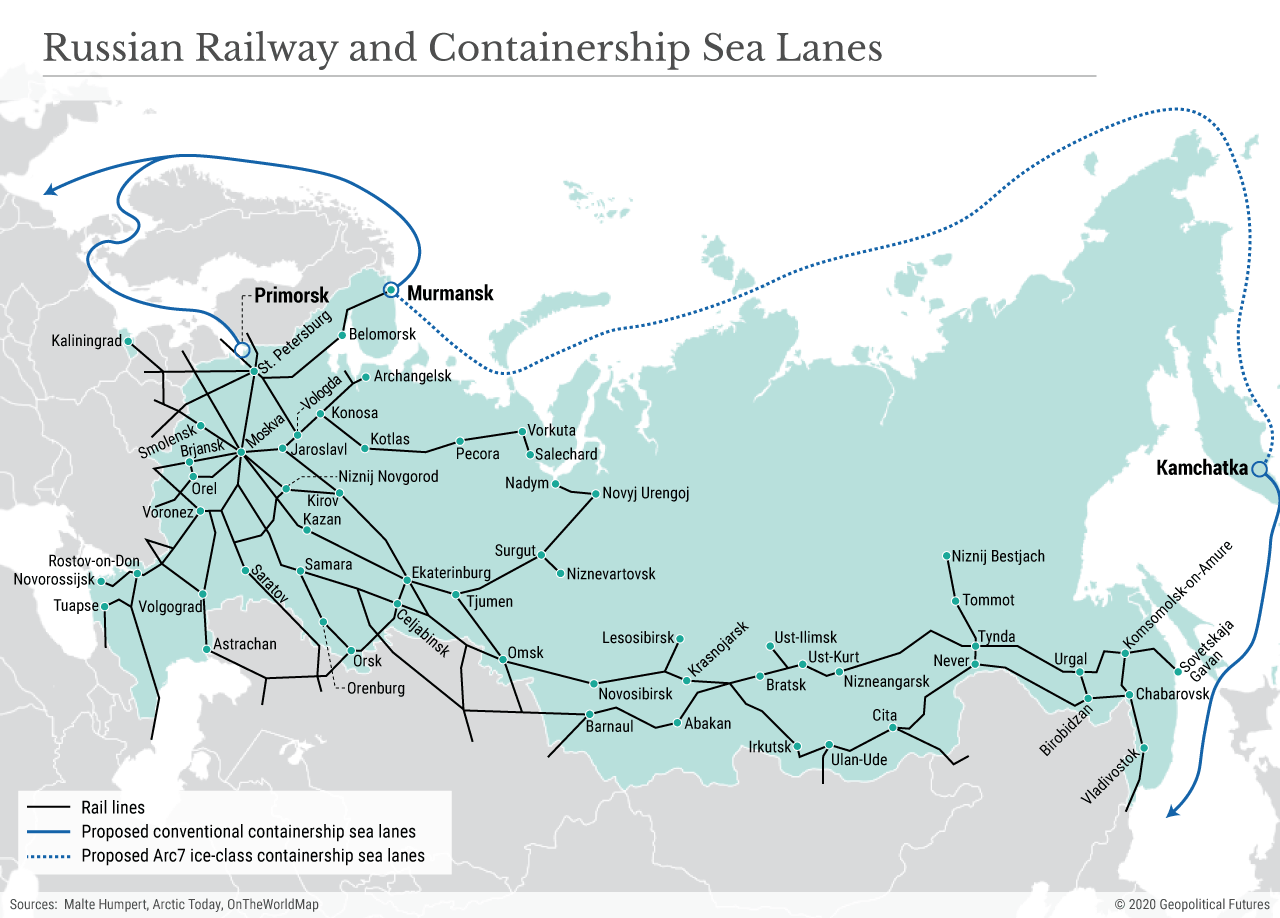By Ekaterina Zolotova
The Russian government is reigniting its push into the Arctic. Despite the challenging global economic environment, the Kremlin plans to build at least five new icebreakers, which, according to Prime Minister Mikhail Mishustin, will be used to further develop the Northern Sea Route across Russia’s Arctic coast. On Monday, Russia announced that it had started construction on the Leader project, the world’s most powerful nuclear-powered icebreaker, at the Zvezda shipyard in the Far East region. According to the government, the project is worth the expense because it will help make the Northern Sea Route accessible year-round and tap into the growing interest in the new transit corridor between Europe and Asia. But the Kremlin’s own interest in the Arctic is not only a result of the potential economic benefits; it’s also a matter of securing Russia’s eastern borders.
The Eastern Front
Russia has long concentrated its security efforts on its western front. The main threats to Russia’s territorial integrity have historically emanated from there, and so it has spent considerable time and resources building up its Baltic and Black Sea fleets. But Moscow is increasingly focusing on its eastern frontier, which is facing growing threats from several sources, some of which are building up their own naval capabilities. Japan, the United States (through the Bering Strait) and China are all neighbors of this region, and though it’s unlikely that any of these countries would initiate military action against Russia’s east, Moscow is taking no chances, initiating steps to increase the fleet’s combat effectiveness in order to guarantee that no nation can block its access to the Pacific. It also faces internal threats. This is a massive and remote region with poor infrastructure, making it potentially difficult to control. Maintaining the unity of such a vast territory requires a strong military.
Russia has thus been beefing up its military presence in this region by developing the Pacific Fleet’s technical base and boosting its combat effectiveness. The fleet currently has 58 surface ships and 20 submarines, including strategic missile submarines and multipurpose nuclear and diesel submarines. It also has marine missiles, anti-submarine and fighter aircraft, and coastal troops. In fact, the Pacific Fleet is the second-largest and most efficient of Russia’s fleets and has a wide range of tasks, including protecting Russia’s exclusive economic zone and ensuring access through these waters for commercial and military vessels. Its operational area, which includes the Arctic, Southern Hemisphere, Pacific Ocean and Indian Ocean, is the largest of all of Russia’s fleets.
To maintain its combat effectiveness, the Pacific Fleet needs to be constantly modernized and supplied with up-to-date equipment. But this requires large investments as well as complex logistics and fleet support. The Pacific Fleet’s main weakness is its remoteness; it’s poorly connected to Russia’s center as well as the country’s other fleets and flotillas. This is due to the fact that roads and infrastructure in this part of the country are poor – there are only three railways connecting the Far East to the center of the country, for example. There are several railway projects under construction, but they won’t be ready until 2030. The region’s complex terrain, consisting mostly of uplands, makes road and infrastructure development difficult. So Russia is now turning to an alternative path to connect the Pacific Fleet with the rest of the country: the Northern Sea Route.
Icebreaker Revamp
Russia’s long-term strategy is to turn the Northern Sea Route into a transport corridor that would be accessible year-round from Murmansk to Vladivostok, the location of the Pacific Fleet’s main headquarters. But even taking into account the effects of global warming, it’s unlikely that the ice in this area of the Arctic will melt enough in the next 10-20 years to make these waters traversable for commercial or military vessels. This means that the future of the Pacific Fleet depends primarily on how quickly and efficiently the Kremlin can create a unified network that connects the fleet’s infrastructure with the center. Considering the thickness of the ice in this region, which can exceed 2 meters (6.5 feet), it’s hard to imagine that this would be possible without a modern icebreaker fleet.
Russia proudly says that it is the only country that has a nuclear-powered icebreaker fleet: two 75,000-horsepower twin-reactor icebreakers called Yamal and 50 Years of Victory, and two 50,000-hp single-reactor icebreakers called Taimyr and Vaigach. It also has the Sevmorput nuclear-powered container ship with 40,000 hp capacity.
The fleet is in need of a revamp, however. Three of the four nuclear-powered icebreakers will be decommissioned by 2030, with the fourth going out of service in 2035. Russia is therefore planning to build new icebreakers. Rosatomflot, which operates the four aforementioned ones, will receive three new icebreakers (the Arctica, Siberia and Ural) as part of Project 22220. Arctica reached the final stage of sea trials in late June. Two additional nuclear-powered icebreakers are planned at a cost of 100 billion rubles ($1.4 billion).
In addition, the government approved in January the construction budget, totaling 127.5 billion rubles, of the Leader nuclear-powered icebreaker. This vessel can break up to 4.3 meters of ice and operate year-round. Moscow plans to have three Leader-type icebreakers operational by 2033. By 2035, the Kremlin plans to have at least 13 operational heavy-duty icebreakers, nine of which will be nuclear.
Financing
Though the total cost of all these projects is unknown, they definitely won’t be cheap. Nuclear-powered icebreakers – as well as the ports, roads and other infrastructure needed to operate them – are extremely expensive to build. The Kremlin is the main financier of these Arctic projects, but considering the collapse of oil prices and the fallout from the coronavirus pandemic, the federal budget is extremely tight.
The Kremlin is thus looking for other ways to finance construction of the new icebreakers. It has unveiled a new strategy to develop the Arctic zone until 2035 that will include attracting investment and creating jobs. It wants to build an Arctic trade route for international shipping – a project that has been a priority for President Vladimir Putin since he introduced the idea in 2018. Putin believes the cargo turnover of the Northern Sea Route can reach 80 million tons by 2024, a highly ambitious goal considering that turnover was 10.7 million tons in 2017, 20.2 million in 2018, and 31.5 million in 2019. Putin’s goal could be achieved only through large investments and expanding the borders of the Northern Sea Route to include the Barents, White, Pechora, Bering and Okhotsk seas. In the short term, Moscow wants to increase investment interest in the route, which means providing incentives, developing trade and creating a favorable business environment. The Ministry of Natural Resources and Ecology generally supports the liberalization of access to the Arctic shelf. On June 23, the State Duma passed a bill in the second reading that would create a special regime for businesses operating in the Arctic, including tax benefits, a register of participants and a free customs zone.
Russia’s long-term goal to develop the Northern Sea Route and build nuclear icebreakers is extremely costly. But given the need to secure the eastern frontier, Russia will continue to invest millions in the Arctic, despite the challenging economic times, even if it means running a deficit. It believes that bridging the gap between the Pacific and the rest of the country is worth the cost, and hopes that it will pay off financially in the future.


No comments:
Post a Comment